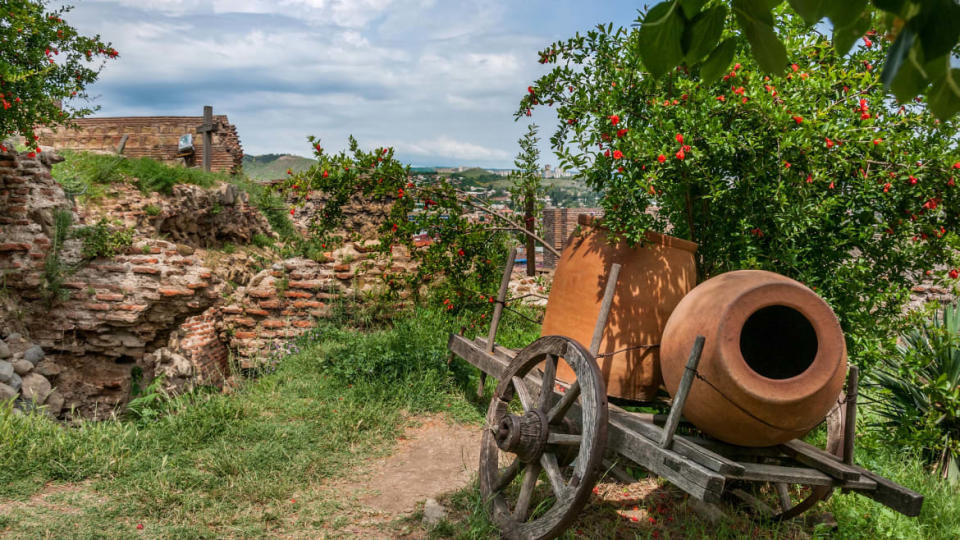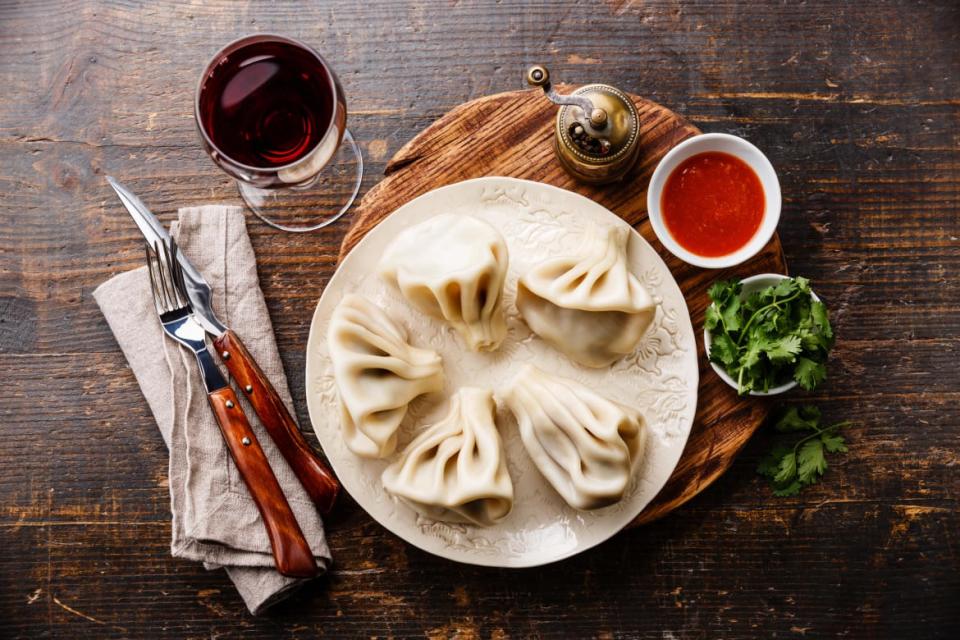Hate Pretentious Wine Tastings? Visit This Country

When I visited winemaker Levan Andronikashvili a few weeks ago, his cellar sounded like a dozen cauldrons of soup boiling simultaneously. The sputtering from the fermenting vats was so feverish I could hardly hear his instructions over the din: “Quick, grab that pole! Let’s punch down the grape skins!” Seconds later I was breaking a sweat, turning his freshly pressed grapes into wine.
Spontaneous thrills like helping a farmer with punch-down are typical in Georgia—locals are so hospitable that at most wineries you’re received as a houseguest as opposed to a tourist. Swirling cabernet in a tasting room is one thing; wolfing down soup dumplings in a winemaker’s backyard to the backdrop of the Caucasus Mountains, your fingers still sticky with rkatsiteli juice, is another entirely. This is wine tourism returned to its roots: rustic, generous, and delicious in every sense.
Even jaded enophiles will geek out in Georgia. For starters, the country has roughly 400 native grape varieties, a staggering diversity for a country smaller than Ireland. Tsitska, jghia, mtsvane, saperavi—Georgia’s consonant-heavy grapes are as exotic to the Western palate as they sound, bearing what seems to be no genetic relation to the European grapes that dominate the market. Translation: You’ve never tasted wines like these before.

Kvevri, earthenware vessels for wine, in Georgia.
More fascinating still is the way Georgians make wine, not in tanks or oak barrels but, traditionally, in clay pots buried in the ground called kvevri. In these tear-shaped vessels, the fresh juice hangs out with the chacha (skins, pips, and stems) sometimes for months, which gives the wine a chewiness and heft that sometimes reminds me of tea that was steeped for an extra minute. When the grapes are white, all that skin contact makes the wine darker, hence the term amber wine. “Everybody is experimenting with skin contact these days,” said Lisa Granik, author of The Wines of Georgia and Granik’s Guide to Georgian Wine, in a phone interview. “Well, guess what? It’s all derivative. This is the real deal.”
Kvevris have been around since at least the Iron Age, but winemaking in the region goes back much farther—like, caveman farther. As far as we know, Georgia is the cradle of wine. In 2017 archaeologists there unearthed ceramic fragments with grape motifs that, through chemical analysis, revealed the world’s earliest evidence of winemaking: The shards were carbon-dated to around 5900 B.C. (2,500 years before the invention of the wheel). It wouldn’t be a stretch to say that Georgia is the ultimate wine pilgrimage—a place to commune with our Stone Age ancestors through a beverage that may not taste so different from how it did millennia ago.
But practically speaking, how does one plan a wine route in Georgia? Learning the lay of the land, a thing or two about Georgian culture, and a few key addresses is a great starting point.
Getting Your Bearings
It’s no exaggeration to say that every Georgian either makes wine or knows someone who does. The whole country is wine country. Even in the built-up blocks of Tbilisi, grapevines curl around railings and up courtyard walls. Yet of Georgia’s 10 viticultural regions, one eclipses the rest: Kakheti, a lush, fertile swath stretching along the base of Caucasus that accounts for 70 percent of the country’s vineyard.
Two hours east of Tbilisi by car, Kakheti is a doable day trip from the capital if you’re crunched for time, though spending at least three nights is ideal if you want to hit several wineries as well as the region’s historical sites. Non-negotiable sightseeing stops include Alaverdi Monastery, a 17-story medieval masterpiece whose wine cellar dates to 1011, and David Gareja, an active sixth-century monastery hewn into a cliffside known for its exquisite frescoes.
Blissfully off the tourist track (for now) but with equally arresting wines is the region of Kartli, situated an hour and a half west of Tbilisi. “It’s a bit cooler than Kakheti, so the wines are fresher and lighter,” explained Granik. A night or two will do in Kartli, whose non-boozy attractions include the uncomfortably anachronous Stalin Museum and Uplistsikhe, an abandoned Stone Age cave town that once housed 20,000.
Every Georgian wine region is a world unto itself that’s worth exploring, but for first-time visitors flying into Tbilisi, Kakheti and Kartli will keep you plenty busy.
Where to Taste
A dozen trips to Georgia have taught me that the country’s best wine is often hidden away in small, independently owned natural wineries whose only PR is word of mouth. The contrast between bland “international” bottles found in Kakheti’s famous wine factories (a Soviet term that stuck) and characterful kvevri wines that have been pampered by passionate winemakers could not be greater. What’s more, the latter go down easier knowing that your lari are propping up family farms at a time when they could really use the help.
In Kakheti, Chona’s Marani (“marani” means winery in Georgian) makes a terrific first stop. Here, in the flower-fringed backyard of Michael Chonishvili, you’ll embark on a leisurely taste tour of the region’s signature varietals, from honeyed rkatsiteli to plummy saperavi to floral kisi—all textbook-precise. As Chonishvili gives you the lowdown on kvevri winemaking, you’ll snack on shoti bread swooshed with nadughi (minty whipped cottage cheese) and slices of his mother’s homemade churchkhela, a traditional walnut-wine confection that ancient Kakhetian warriors purportedly took to battle as a sort of primordial energy bar.
With the basics of Kakhetian wine under your belt, you’re equipped to appreciate the zany experiments of young winemaker Beka Nasrashvili, whose namesake marani combines European and Georgian techniques to produce such intriguing wines as lees-aged mtsvane and bone-dry black muscat. If you haven’t yet tried khinkali—Georgian soup dumplings flecked with cilantro and caraway—this is the spot to surrender to their dribbly goodness, grease stains be damned. (Be sure to request lunch in advance.)

Georgian dumplings Khinkali with meat, tomato spicy sauce and wine
Chonishvili and Nasrashvili, like most Georgian winemakers, don’t sit on their wines for more than a year or two, but at Andronikashvilis Marani (by email booking only: levan@marani.organic)—where I was put to work punching down kvevris—you have the rare chance to savor a multi-vintage tasting of the same wine. This is called a “vertical” in somm speak, and it’s magical because it shows you how the same grapes can produce totally different wines year over year due to weather and other factors. Spoiler alert: The 2015 rkatsiteli, redolent of walnuts and orange peel, is an absolute knockout.
When you’ve had your fill of rkatsiteli and saperavi, Kakheti’s inescapable standby varietals, head to Wine Artisans (bookings via Meet Me Here Tbilisi) in Kartli to change things up. There, down a gravel road on a gorgeous estate encircled by cliffs, winemaker Andro Barnovi coaxes local grapes like smoky chkhapa and cherry-scented tavkveri into sublime kvevri wines that are some of the region’s finest. A Georgian saying goes that a bad man can’t make good wine, and that checks out for Barnovi: In the wake of recent homophobic attacks on LGBT+ activists and journalists in Tbilisi that resulted in the death of a reporter, Barnovi galvanized dozens of Georgian winemakers to sign a letter condemning the acts.
Where to Stay
Accommodations are so affordable in Georgia that even penny-pinching travelers can ball out. In Kakheti, I like to post up at Vazisubani Estate, a converted 19th-century mansion with snug carpeted rooms, a trendy café-restaurant, and an infinity pool overlooking the property’s own vineyards. It’s so pleasant that much of the clientele is Georgian.
Guest houses, family-run accommodations where the rate includes breakfast, dinner, and—of course—wine, abound in Georgia. I love Nika Vacheishvili’s Marani in Atenuri, Kartli, for its clean, refreshed digs (think blond woods and floor-to-ceiling glass windows) and homemade wine made from the delicate local chinuri grape. Vacheishvili used to be Georgia’s minister of culture; a font of knowledge, he’s especially fun to drink with. (The best service for finding guest houses is Booking.com).
Tour Operators
Driving in Georgia while sober is harrowing enough—you won’t want to get behind the wheel after winery-hopping. Enter InterGeorgia Travel, a seasoned English-speaking tour company whose owner, Kartlos Chabashvili, is a native Kakhetian with fantastic local contacts. With rates around $100 per day per vehicle, booking with Chabashvili is a worthwhile investment. Other notable operators include Trails & Wines, headed up by Georgia, a Guide to the Cradle of Wine coauthor Daria Kholodilina, and Meet Me Here Tbilisi, an outstanding resource for all things Kartli.
Get our top stories in your inbox every day. Sign up now!
Daily Beast Membership: Beast Inside goes deeper on the stories that matter to you. Learn more.

 Yahoo Finance
Yahoo Finance 